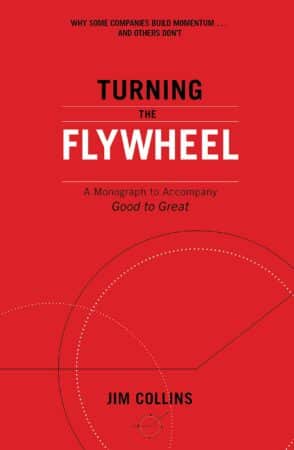
Like a few other “books” I’ve reviewed, this one is too short to even classify as a book. However, it’s also super important, so I do want to review and recommend it.
Turning The Flywheel can be better classified as a companion to Jim Collins’ masterpiece Good to Great. In Good to Great, Collins explains the flywheel concept. Here he dives in much deeper:
“Picture a huge, heavy flywheel—a massive metal disk mounted horizontally on an axle, about 30 feet in diameter, 2 feet thick, and weighing about 5,000 pounds. Now imagine that your task is to get the flywheel rotating on the axle as fast and long as possible.”
“Pushing with great effort, you get the flywheel to inch forward, moving almost imperceptibly at first. You keep pushing and, after two or three hours of persistent effort, you get the flywheel to complete one entire turn.”
“You keep pushing, and the flywheel begins to move a bit faster, and with continued great effort, you move it around a second rotation. You keep pushing in a consistent direction. Three turns … four … five … six … the flywheel builds up speed … seven … eight … you keep pushing … nine … ten … it builds momentum … eleven … twelve … moving faster with each turn … twenty … thirty … fifty … a hundred.”
“Then, at some point—breakthrough! The momentum of the thing kicks in your favor, hurling the flywheel forward, turn after turn … whoosh! … its own heavy weight working for you. You’re pushing no harder than during the first rotation, but the flywheel goes faster and faster. Each turn of the flywheel builds upon work done earlier, compounding your investment of effort. A thousand times faster, then ten thousand, then a hundred thousand. The huge heavy disk flies forward, with almost unstoppable momentum.”
“A flywheel is an underlying, compelling logic of momentum … there’s an inevitability built in. If you do A, you almost can’t help but do B. And if you do B, you almost can’t help but do C. And if you do C, you almost can’t help but do D. And around and around. And it’s driven around because there’s an underlying connection. There’s a logical sequence that builds dynamic momentum because A drives B drives C drives D and around back to the top of the loop.”
“The key is you build it over a long period of time. The power of a flywheel is that it’s an underlying logic, it’s an underlying architecture.”
Collins dives into how many companies, including Amazon, have created their flywheel.
Good to Great is a top five must-read for every entrepreneur. This companion is a must-read immediately after.